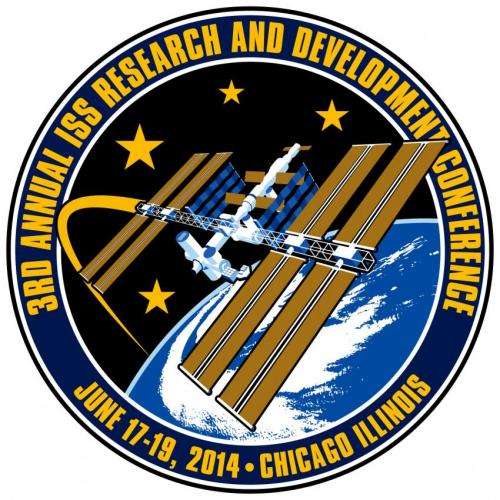Top engineering development and technology maturation projects from International Space Station for 2013

The International Space Station (ISS) is not just an orbiting laboratory full of traditional research seen through the microscope; it also serves as an important technology test bed. Based on findings published last year, three of the best technology applications were recognized at the third annual ISS Research and Development conference on June 18, 2014.
The following winners in the 2013 Top Engineering Development and Technology Maturation with a Focus on Commercial and Exploration Applications category shared their research while taking part in the fourth plenary panel of the conference:
- Gabriel Lapilli, research engineer at the Florida Institute of Technology, was recognized for outstanding results from the SPHERES-Slosh investigation.
- Vladimir Grigoriev of the Russian Federal Space Agency, Systems of Precision Instrument Making, was recognized for a Space Experiment for In-Flight Testing of a Laser Communications System on the Russian Segment of the ISS.
- Jeffrey Sweterlitsch, Ph.D., Amine Swingbed Principal Investigator in the Life Support Systems Branch at NASA's Johnson Space Center, was recognized for outstanding results from the Amine Swingbed Technology demonstration.
"These selected awardees are elevating space technology to a whole new level, executing tests and demonstrations that show we can improve our spacecraft designs and further our space exploration," said Allyson Thorn, NASA ISS Research Integration Office, who was part of the award selection committee.
This year's conference theme is discoveries, applications and opportunities. To be exact, the theme focuses on discoveries in microgravity, space and Earth science, as well as engineering and education; applications benefitting Earth, enabling technology and forwarding exploration; as well as opportunities for use of this innovative laboratory. The conference takes place from June 17 to 19 in Chicago.
Currently operational on the space station, the Synchronized Position Hold, Engage, Reorient, Experimental Satellites (SPHERES)-Slosh demonstration seeks to understand how fluids move inside containers during long-duration flight in microgravity. The goal is to simulate how rocket fuels move around inside their tanks, in response to motor thrusts used to push a rocket through space. Validating the fundamental physics behind liquid slosh in microgravity is important because Earth's most powerful rockets use liquid fuels to take satellites and other spacecraft into orbit and make trajectory corrections throughout their lifetime. The SPHERES-Slosh investigation may enable advanced technology for the next generation of spacecraft that will travel to an asteroid, Mars and beyond.
This technology also may help advance understanding of how liquid behaves on Earth, whether in simple applications such as avoiding a spill from a coffee cup or more complex applications like an oil-carrying vessel traveling through the ocean or how to create novel building damping devices in earthquake-prone areas.
"We have achieved an important goal - collect the world's premiere long-duration liquid slosh data in microgravity - which was possible due to the research opportunities the space station provides," said Lapilli. "The research team feels extremely happy and honored to receive this award. It is great recognition for the hard work done by the entire SPHERES-Slosh team at Florida Institute of Technology, NASA's Kennedy Space Center, Johnson Space Center, Ames Research Center, Marshall Space Flight Center and the Massachusetts Institute of Technology."
The Space Experiment for In-Flight Testing of a Laser Communications System on the Russian Segment of the ISS was a two-year investigation of a laser communication system to perform high-speed transmission of information between the space station and a ground-based terminal in Russia. The laser communication system testing confirmed its functionality in spaceflight and during both day- and nighttime. The results are applicable for development and application of new broad-band laser communication systems between spacecraft in low-Earth orbit and ground-based laser terminals on Earth and laser communication between two or more spacecraft.
This laser communication technology will help support space exploration, especially in the area of commercial development of low-Earth orbit, where more spacecraft will be in orbit and will need quick, efficient communications capabilities. These systems optimize communications from space, leading to higher definition video feeds and faster research data transmissions from satellites and the space station. Laser communications systems like this one include the new Optical Payload for Lasercomm Science (OPALS) aboard the space station.
The Amine Swingbed was a technology demonstration of an amine-based carbon dioxide and water vapor removal system aboard the space station between May 2013 and February 2014. The Amine Swingbed is the baseline technology for controlling carbon dioxide and humidity in the habitable spacecraft for Orion's Multi-Purpose Crew Vehicle. The technology demonstration also successfully employed water-saving and air-saving subsystems to reduce resources normally vented to the vacuum of space.
Combined with other support systems aboard the space station, this technology can be used to help save resources for long-duration spaceflight. Amine-based recovery systems also can operate on Earth to help remove carbon dioxide and humidity in tight spaces, like in mine tunnels or submarines. The project also advanced the research team's knowledge and experience, enabling replication of this technology for future NASA space exploration projects.
"I am surprised and flattered by this award," said Sweterlitsch. "I am accepting this award on behalf of a large group of people - more than 160 at different stages of the project - who were dedicated to conducting this activity. We got to a point where we were able to communicate directly with the crew, exchanging real-time feedback about the installation procedures, which was really beneficial to the project. This facilitated some great research to be conducted. We also learned more about our system and how it performs in a relevant spacecraft environment and benefits the space station because it provides an option for contingency carbon dioxide removal support."
Provided by NASA/Johnson Space Center




















